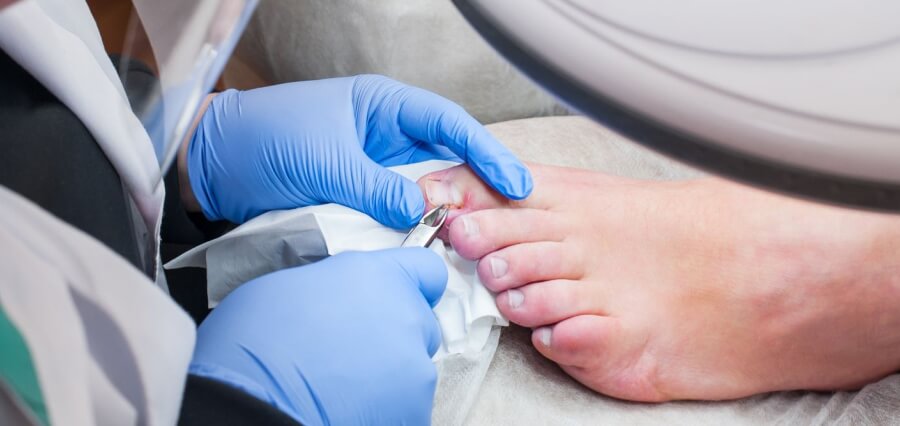Dealing with the pain and discomfort of an ingrown toenail can be incredibly frustrating. When basic treatments fail to provide relief, ingrown toenail surgery becomes a practical option.
Ingrown toenail surgery, or Onychocryptosis surgery, is a relatively simple and common procedure to treat severe or recurring cases of ingrown toenails. This operation involves the removal of the ingrown portion of the nail and, in some cases, addressing the underlying causes to prevent future occurrences.
If you’re considering having one, this article will help you understand the surgery procedure and ensure a smooth recovery.
The Procedure of Ingrown Toenail Surgery
1. Preoperative Assessment
A trained healthcare practitioner thoroughly evaluates the ingrown toenail before surgery. This evaluation helps determine the condition’s severity and confirms if surgery is the best course of action. The patient’s medical history is also examined to spot any potential issues.
2. Anesthesia Administration
To ensure your comfort during the procedure, anesthesia will be administered. This may involve either local anesthesia, which numbs the toe while you remain awake, or general anesthesia, which induces sleep throughout the surgery.
3. Toe Preparation
Once the anesthesia has taken effect, the surgeon will use antiseptic solutions to cleanse the area around the ingrown toenail. Sterile drapes will be placed to minimize the risk of infection and create an ideal environment for the surgical procedure.
4. Nail Plate Removal
The damaged part of the nail plate is then trimmed away. A surgeon will carefully lift the ingrown section of the toenail and make a small incision on the affected side. Nail avulsion, in which the entire nail plate is extracted, may be performed for severe or chronic ingrown toenails.
5. Matrix Destruction or Chemical Cauterization
In some cases, the surgeon may destroy the nail matrix or use a chemical cauterization technique to prevent the future reproduction of the ingrown toenail. This step helps prevent the ingrown portion of the nail from regrowing and causing further discomfort.
6. Wound Management
Following the nail plate removal, the surgeon carefully cleans the wound and applies an antiseptic solution to prevent possible infection. Sterile dressings or bandages are also used to protect the area and facilitate healing.
7. Postoperative Care and Recovery
Patients are often given detailed postoperative care instructions to promote a fast recovery and prevent unnecessary problems. Guidelines for dressing changes, hygiene, and pain or discomfort may be included.
8. Follow-up Appointments
To monitor your progress and ensure proper healing, you will be scheduled for follow-up appointments with your healthcare provider. During these visits, they will examine your toe, remove any stitches if necessary, and address any concerns you may have.
Ingrown Toenail Surgery Aftercare
Proper aftercare is essential for a successful recovery and to reduce the risk of complications following ingrown toenail surgery. To ensure the right rehabilitation, consider these procedures:
1. Dressing and Wound Care
After surgery, it’s crucial to properly care for the wound by keeping the dressing dry and clean. Follow your healthcare provider’s instructions regarding dressing changes and the use of any medications.
2. Pain Management
After surgically removing an ingrown toenail, it is usual to feel some pain or discomfort. Your doctor may suggest or prescribe specific painkillers to alleviate discomfort after surgery. If the pain persists or worsens despite taking the prescribed drugs, inform your doctor.
3. Immobilization and Elevation
Keeping the foot immobilized and elevated as much as possible in the early stages of recovery is recommended to support healing and prevent inflammation. When the affected foot is elevated above the level of the heart, swelling is reduced, and blood flow is improved.
4. Physical Activity and Rest
While sleep and other forms of rest are essential for recovery, mild exercise such as walking helps boost blood flow, reducing the risk of complications like blood clots. But it’s important to rest and not put extra weight or force on the incision.
5. Footwear and Toe Protection
To facilitate faster recovery, it is recommended to wear open-toed or loose-fitting shoes. Avoid wearing too narrow or tight footwear since these can pressure the toes or rub against the surgical incision. Your healthcare provider may recommend protective devices to keep the toe safe from unintentional injuries as it heals.
6. Hygiene and Moisture Control
Maintaining good foot hygiene is crucial for preventing infection. Keep the area clean and dry, and follow any foot baths or treatment instructions. Avoiding excessive moisture is important, as this can contribute to infection or delayed healing.
Overcome Ingrown Toenail Surgery with Knowledge
Ingrown toenail surgery can offer long-term relief and improved quality of life. By understanding the procedure and being aware of the necessary steps for recovery, you can confidently approach the surgery and increase the chances of a successful outcome.
With patience and commitment, you can bid farewell to pain and regain mobility and comfort.
Reference:
https://www.medicalnewstoday.com/articles/326019#procedures
https://www.patrickhalldpm.com/blog/ingrown-toenail-surgery-procedure-recovery-complications
https://hillsdistrictpodiatry.com.au/ingrown-toenail-removal-recovery-process/


